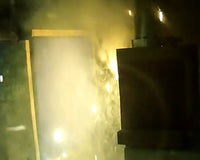An arc flash risk assessment is a calculation performed by a licensed professional engineer to determine the incident energy found at each location which determines the arc flash boundaries and what personal protective equipment (PPE) must be used by the employee.
What are the 3 main factors in an assessment?
NFPA 70E states that the goal of an arc flash assessment is a three step process:
- Identify a hazard.
- Estimate the likelihood of occurrence and the potential severity of injury.
- Determine if additional protective measures are needed.
While teaching a group of electrical workers why one task is considered an arc flash risk and another task is not (even while performed on the same equipment under the same environmental conditions) we came to the realisation that there is one key factor in arc flash risk assessment… determining likelihood.
If you can determine the likelihood of an Arc Flash happening, then your risk assessment is 99% complete.
Let us take you through the steps of risk assessment (while keeping Arc Flash in mind) and it should be clear to you that the only step that really counts is the likelihood step.
Arc Flash Risk Assessment Steps
1. Identify the hazards
Ok… Arc Flash… check.
2. Estimate severity
Bad, really bad, or extremely bad.
It doesn't really matter which it is.
In all cases, if you are exposed to this hazard it's not going to be pretty.
This is the reason why the likelihood becomes so important. It’s the only variable that is left to decide whether or not you are going to wear PPE or take any additional precautions to perform your task.
3. Estimate likelihood
Ask yourself this question:
Is there a chance that what I’m about to do could cause an Arc Flash blast?
That’s it. Yes, or no.
Because the severity is so high, even a task that only has a remote chance of causing an arc flash needs to be considered risky enough to warrant the use of Arc and Flame Resistant PPE (or other precautionary measures).
4. Determine protective measures
If you ended up with a ‘yes’ from step 3 then this is where you simply look at the Arc Flash Label to identify the amount of Incident Energy available or if you don’t have a label you’ll need to follow the “arc flash category method” that is outlined in NFPA70E.
Let’s recap the situation.
You are dealing with a possible Arc Flash, you never want to get burned no matter the available energy, and you'll always wear Arc PPE to protect yourself from the risk (that’s steps 1,2, and 4 for those of you following along).
The only time you do not wear PPE is when the likelihood of an arc flash happening is low, examples of these situations would be;
- In an office
- On de-energised lines
Still need help determining likelihood?
The NFPA70E technical committee actually makes it pretty easy.
They have a table called “Arc flash hazard identification for alternating current (ac) and direct current (dc) systems”.
In my opinion, they could have named it “the likelihood table”.
It’s just a big list of tasks that one might find themselves doing and a ‘yes’ or ‘no’ if they require Arc Flash PPE while they do it.
If you are stumped as to whether or not the task you are doing is likely to cause an arc flash, then see if you can find it or a similar one in the table.
How did the technical committee determine the likelihood?
They used the concept of normal operation.
To determine normal operation the asked themselves this question…
"Am I operating (or interacting) with this equipment in a manner that it is designed to be operated?"
If the answer is ‘no’ then you are likely to cause an arc flash.
For example, disconnects, switches and breakers are designed to be operated… so it’s unlikely those activities will cause an arc flash to happen.
Rack in rack out breakers are not designed (for the most part) to be racked in or out on a live bus… so the likelihood in this case will be high.
Arc Risk Assessments are a lengthy, but necessary process. If you need support on the steps contact us here.
Here are some additional questions and answers we hear often regarding Risk assessment, who should do them and how much do they cost.
How often are Arc Flash risk assessments required?
As per NFPA 70E, an arc flash assessment is required to be re-done every 5 years or any time modifications are made to the equipment that can affect the outcome of the assessment. Major or sometimes minor variations, such as fuse type or breaker setting adjustments, can have a huge impact on safety.
Who is an assessment required by?
OSHA doesn’t have a specific requirement mandating that employers have an arc flash assessment conducted with their workplaces. However, there a several OSHA requirements that are broader in terms of protecting workers from electrical hazards.
For instance, the employer is responsible for assessing the workplace to determine if hazards are present, or are likely to be present, which necessitate the use of PPE. Further regulations set forth guidelines on the distribution of PPE.
OSHA states that a qualified person shall use test equipment to test the circuit elements and electrical parts of equipment to which employees will be exposed and shall verify that the circuit element and equipment parts are deenergized.
So while OSHA does not specifically mention arc flash assessments within their recommendations, an assessment can certainly be a step towards meeting these more general requirements.
NFPA 70E addresses how to implement an electrical safety program, how to establish safety related work practices, how to establish methods and use mathematical formulas to evaluate electrical shock and arc flash hazards, and how to select and use electrical shock and arc flash PPE.
IEEE 1584 determines how the ARC Flash Incident energy should be calculated.
Again, it does not explicitly state that an arc flash assessment must be performed by the employer.
What is the cost of an arc flash assessment?
The average cost of performing an arc flash assessment in the UK ranges between £15,000 - £35,000. This includes a full study, plus thermal value rating calculations for PPE.
Whilst this may seem like a lot of money, it is much cheaper than the cost of fines, litigation, reputational damage etc. that an employer would be subject to if a worker was injured by an arc flash explosion in an environment where an assessment wasn’t completed.




